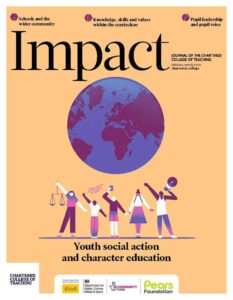Best-evidence curriculum implementation for basic education in Sub-Saharan Africa

OE Ogunseemi, Y Eniola-Arigbe and BV Olanipekun, College of Education, Ikere-Ekiti, Nigeria
The core aim of education is to foster the all-round development of the child, which involves the intellectual, physical, moral, social and emotional needs of the child. However, school activities in Nigeria today are confined to the teaching of the prescribed syllabi, while more than half of daily activities in school are structured and restricted to the four walls of the classroom. Even though activities outside the classroom have been recognised for the value that they could impart to students, in Nigeria they are presently handled as if they have no link with the core teaching programmes. This article highlights the importance of striking a balance between core-curriculum and co-curricular activities at the basic education level, where the foundation for every education is laid.
What is co-curricular?
Co-curricular activities, according to Khan (2019), are programmes and learning experiences that complement and supplement what students are learning in school. Co-curricular activities make up an educational programme that provides for the all-round development of the child, relating to the 3Hs (head, heart and hands), or rather the cognitive, affective and psychomotor objectives of education (Khan, 2019).
Co-curricular activities are those that are undertaken alongside curricular activities. Co-curricular activity essentially takes place outside of the typical classroom environment, and allows students to develop particular skills and exhibit their non-academic abilities. These activities might be compulsory, such as the music, art or drama classes that take place during the day. Others are generally voluntary, such as participating in school sports teams, the school debating team or student newsletters. In any case, participation can assist students in more than one way.
Co-curricular activities complement curricular activities as well as educating students in the art of living and working together. Dream Career (2015) states that they are the true and practical experiences gained by students when they take responsibility for their learning. This is in line with a Chinese proverb that states: ‘Teach me, and I will forget. Show me, and I might remember. Involve me, and I will never forget.’ Co-curricular activities encourage several values, such as:
- educational values
- psychological values
- development of social values
- development of civic values
- physical development values
- recreational values
- cultural values.
Among other things, co-curricular activities help to accomplish the objectives of education through free expression, debate and co-ordination. They help in developing the capacity for leadership, the habit of constructive competition, decision-making, social responsibility and diversityThe recognition of individual differences in terms of race, ethnicity, gender, sexual orientation, socio-economic status, physical ability, religious beliefs and other differences (Dipankar, 2020).
Co-curricular activities are proposed to be given top priority in Nigeria’s educational system, as is currently the case in countries such as Malaysia, Singapore, Australia, Britain and America. Therefore, policy-makers should take responsibility for the development of a curriculum involving co-curricular activities in Nigerian schools, whereby students will learn at least one one skill among the following:
- computing/typewriting
- wirework and bead-making
- soapmaking
- shoemaking
- baking
- sewing and ornamentals
- tie and dye
- drama/dance and photography
- art/crafts, printing and graphics
- musical activities.
The above will run side by side with the students’ involvement in cadet activities, sports, Boy Scouts, Girls Guides, Red Cross, literary and debating societies, environmental clubs, science clubs, young farmers club, music and drama.
In the early days of education, particularly in Nigeria, the primary emphasis was on the learning of information and the pursuit of knowledge, through rote learning of facts and the reading of the classics. However, Adeyemo (2010) discovered that students who participate in activities are found to be more academically sound than their counterparts who do not. Co-curricular activities, according to Ritchie (2018), provide students with alternatives to misbehaviour in their leisure time, as well as reducing the intake of substances like drugs and alcohol when they are not in school. According to Lewis (2004), co-curricular activities strengthen the ties between the students and their school, and so bring about retention and connection with the programmes of the school. Baker (2008) has pointed out the merits and disadvantages of co-curricular activities, in the sense that some activities result in better student integration and enhanced academic activities, whilst others can bring about distractions, undue competition and school drop-out. In another study, Fredricks and Eccles (2008) found that involvement in co-curricular activities helped students with time-management and choosing their friends, as well as guiding them in their characters. However, irrespective of several submissions on the subject of co-curricular activities, education is a broad concept that transcends the four walls of a classroom, and will be inevitably limited without attention to the overall development of the child. Such education, according to Kisango (2016), comprises curricular and co-curricular activities that combine academic learning experiences with opportunities to learn and develop skills through active participation. Moreover, Dipankar (2020) posits that the world is changing fast and that the conventional education curriculum should pave the way for a new type of practice that will foster the holistic development of the child.
Discussion and conclusion
Co-curricular activities have positively impacted the holistic development of our students. Learners here are encouraged to get involved in activities that enhance their skills and their growing capacity for free expression and co-ordination. Among other things, co-curricular activities also help learners to develop the capacity for leadership, a habit of constructive competition, decision-making, social responsibility and approaches to diversity and acceptance of peers.
Co-curricular activities prepare students practically for the future. The core curriculum can only go so far in teaching students about academic theories, while co-curricular activities take learners out of the confinement of the classroom. Learners whose only experience of school is rigid academic study will have nothing to apply to daily situations. However, if co-curricular activities are placed on an equal footing with the core curriculum, there will be an improvement in students’ ability to see the bigger picture both in and outside of the classroom. This reflection has outlined a framework by which school activities can be designed to create an opportunity for the all-round development of the child.
Recommendations and suggestions
Government and policy-makers at all levels should embrace and accept programmes of co-curricular activities by engaging the services of curriculum experts with the support of practitioners for the integration of curricular and co-curricular programmes in the school system. However, in addition to embracing the benefits of co-curricular activities, there is a need to guide against any detriment through follow-up programmes that assist in retaining the experiences of co-curricular activities, particularly for the entrepreneurial mindset development of the learners, in line with a 21st-century education.
References
Adeyemo SA (2010) The relationship between students’ participation in school-based extracurricular activities and their achievement in Physics. International Journal of Science and Technology Education Research 1(6): 111–117.
Baker C (2008) Under-represented college students and extracurricular involvement: The effects of various student organizations on academic performance. Social Psychology of Education 11: 273–298.
Dipankar S (2020) Importance of co-curricular activities for students. i Dream Career. Available at: https://idreamcareer.com/blog/importance-of-co-curricular-activities-for-students (accessed 6 August 2020).
Dream Career (2015) Importance of co-curricular activities for a student. professional services put Ltd. https://idreamcareer.com/blog
Fredricks JA and Eccles JS (2008) Participation in extracurricular activities in the middle school years: Are there developmental benefits for African American and European American youth? Journal of Youth and Adolescence 37(9): 1029–1043.
Khan A (2019) Role and importance of co-curricular activities at school. Jagran Josh. Available at: www.jagranjosh.com/articles/role-and-importance-of-cocurricular-activities-at-school-1507643588-1#:~:text=Co%2Dcurricular%20are%20designed%20and,and%20character%20appeal%20in%20students (accessed 6 August 2020).
Kisango B (2016) Factors influencing students’ participation in co-curricular activities in public secondary schools in Lamu County Kenya. Research project report, Master of Education in Curriculum Studies, University of Nairobi, Kenya.
Lewis CP (2004) The relation between extracurricular activities with academic and social competencies in school age children: A meta-analysisA quantitative study design used to systematically assess the results of multiple studies in order to draw conclusions about that body of research. PhD Dissertation, Texas A&M University, USA. Available at: https://core.ac.uk/download/pdf/147124443.pdf (accessed 6 August 2020).
Ritchie GM (2018) The impact of academic co-curricular activity participation on academic achievement: A study of Catholic high school students. Seton Hall University Dissertations and Theses (ETDs). Available at: https://scholarship.shu.edu/cgi/viewcontent.cgi?article=3564&context=dissertations (accessed 6 August 2020).










